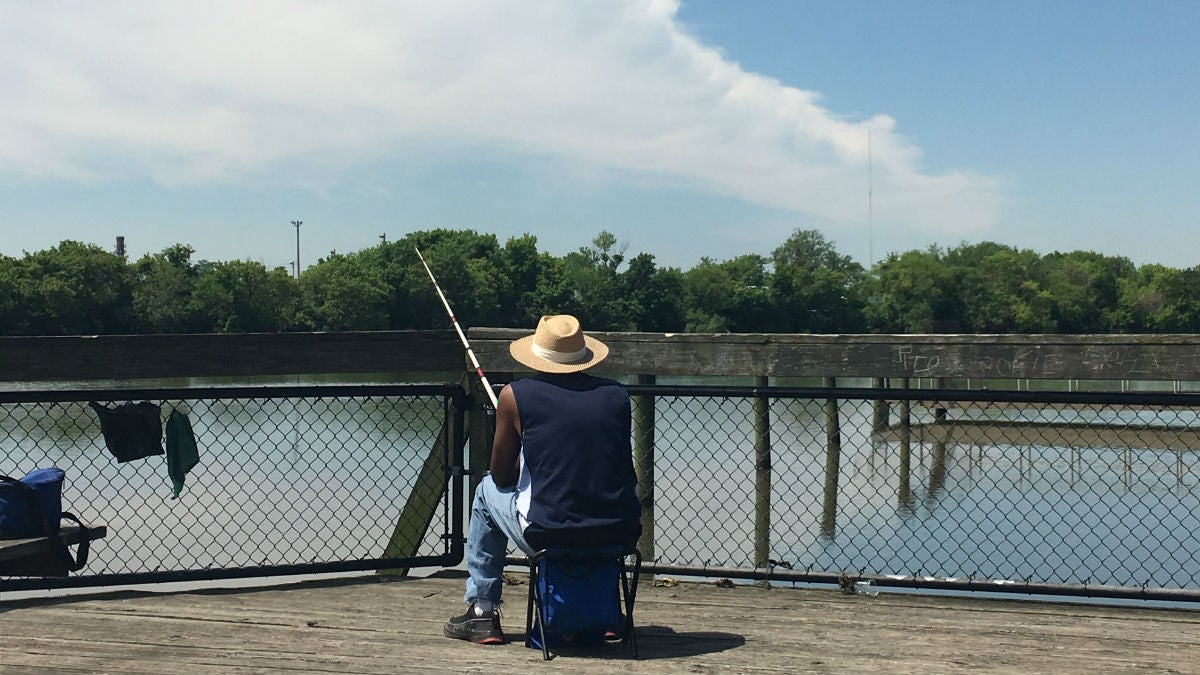Improved water conditions in some Delaware rivers [video]

An angler fishes off a dock along the Christina River in Wilmington. (Mark Eichmann/WHYY)
Improving conditions in some Delaware rivers mean more locally-caught fish could soon be on your table.
On a bright summer morning, the sun’s shining off the water flowing along the Christina River in Wilmington. Anglers along the shore are hoping the fish are biting. While a seemingly idyllic scene, the impact of decades of industrial and urban build-up has taken a toll on the fish swimming through these waters. For decades anglers have been limited in their ability to eat what they catch because of pollution in the water.
“Polychlorinated biphenyls, dioxin and furans were historically used and in their day were very effective, but we’ve learned the problems now that come with their use and their existence in the environment,” said David Small, secretary of the Delaware Department of Natural Resources and Environmental Control.
Running through the city of Wilmington, the Christina River was laden PCBs, and because of that the state advised residents not eat fish out of the Christina and other waterways.
Governor Jack Markell called the pollution “the tragedy of the Christina River.” It is among the most contaminated bodies of water in the state. “Laced with legacy toxins, we can’t eat the fish or safely swim in the waters that roll past this refuge every day,” Markell said in 2013 as he presented his plan to fund a major clean water initiative. That effort was defeated by state lawmakers.
Despite that inaction, there’s been some improvement in the water. From 2007 to 2015 the concentration of PCBs has dropped 50 percent in the Christina from the Peterson Wildlife Refuge downstream to where the Christina meets the Delaware River.
“This is significant news,” Small said. “It’s not a home run, but it’s progress.”
The reduction in PCBs led the state to change the fish consumption advisory for the Christina. The previous advice of “eat no fish” has changed, now anglers can eat one eight-ounce meal of fish caught from the Peterson Wildlife refuge to the Delaware River. Anglers fishing further upstream can eat 12 eight ounce meals of fish per year.
“It’s decades in coming. A long time coming,” Small said.” I think we’re finally starting to see the fruits of a lot of investment, large and small cleaning up sites, not using the types of chemicals that we once did, at least as widely as we once did.”
Cleaner, fishable waters contributes to the state’s efforts to draw visitors to enjoy recreation opportunities in and along the state’s waters.
“The diversity of resources that we have here in the state and the water features are a big part of our state park and our fish and wildlife areas,” Small said. “We want everybody to come out and enjoy them and know that they are safe spaces. You want to fish? You can do it, take a fillet home and have at it. That’s what we’re working towards.”
It’s not just the Christina River that is seeing improvement. The state has rolled back restrictions on fish consumption for a number of other waterways in New Castle County. Here’s the list of changes:
Tidal Christina River-
The advisory for the Tidal Christina River between Smalley’s Dam (near Christiana) to the Delaware River was updated to less-restrictive advice that includes two areas.
For the area upstream of the Peterson Wildlife Refuge to Smalleys Dam. The current advice of “eat no fish” caught from this area has been revised to “eat no more than 12 eight-ounce meals of fish per year.” The advice also applies to Nonesuch Creek, a tidal tributary of the Christina. This increase in allowable fish consumption is significant and can be attributed to improved water quality flowing from the non-tidal portion of the Christina River into the upper tidal portion of the River. PCBs are the primary contaminant of concern.
Area between the Peterson Wildlife Refuge downstream to where the Christina River empties into the Delaware River. For the general adult population, the current advice of “eat no fish” has been updated to “eat no more than one eight-ounce meal of fish per year.”
Non-Tidal Christina River-
The non-tidal Christina River runs from its headwaters north and west of Newark downstream to Smalleys Dam. The existing advice of “eat no more than six eight-ounce meals of fish” has been doubled to “eat no more than 12 meals per year.”
Little Mill Creek-
A tributary of the Christina River, Little Mill Creek’s headwaters are in Greenville. The Creek flows southward through Elsmere, Canby Park, and the Peterson Wildlife Refuge and empties into the tidal Christina south of Wilmington. The existing fish consumption advisory is to “eat no fish.” New data and assessment found that the current advice can be less stringent and has been revised to “eat one eight-ounce meal of fish per year.”
Tidal Brandywine River-
The Brandywine River is the largest tributary of the Christina River. The tidal Brandywine covers the area between Baynard Boulevard in Wilmington downstream to its confluence with the Christina River. The existing fish consumption advisory is to “eat no fish.” The advice is being increased to “eat no more than two eight-ounce meals of fish per year.”
Non-Tidal Brandywine-
No change in existing advisory. The non-tidal Brandywine runs from the Delaware/Pennsylvania state line to the head of tide near Baynard Boulevard in Wilmington. The data and assessment supports keeping the existing advice to “eat no more than six eight-ounce meals of fish per year.”
Tidal White Clay Creek-
Less restrictive advisory: The lower three miles of the White Clay Creek are tidal between the mouth of the creek and Route 4 in Stanton. Hershey Run, which has a history of contamination, flows into the tidal White Clay Creek. The advisory was updated from “eat no fish” to “eat no more than one eight-ounce meal of fish per year.”
Non-Tidal White Clay Creek.
No change in existing advisory: The non-tidal White Clay Creek originates in Chester County, Pennsylvania and flows into Delaware north of the City of Newark. The existing advice of “eat no more than 12 eight-ounce meals of fish per year” is being retained.
Red Clay Creek-
More restrictive advisory: The Red Clay Creek, which has a long history of contamination in Pennsylvania and Delaware, flows into Delaware south of Kennett Square, Pa. and north of Yorklyn, Del. New data and assessment found that the recommended meal advice needs to be more stringent – from “eat no more than six meals per year” to “eat no more than three meals per year.”
Shellpot Creek-
The headwaters of Shellpot Creek are located near Talleyville and its outlet is in the far eastern portion of Wilmington, just north of the Cherry Island landfill. The advisory was updated to less-restrictive advice that includes two areas:
Upstream of Governor Printz Boulevard. Less restrictive advisory: The current advice of “eat not more than one eight-ounce meal of fish per year” has been revised to “eat not more than two eight-ounce meals per year.”
Downstream of Governor Printz Boulevard. Less restrictive advisory: The current advice of “eat no fish” has been revised to “eat no more than one eight-ounce meal of fish per year.”
WHYY is your source for fact-based, in-depth journalism and information. As a nonprofit organization, we rely on financial support from readers like you. Please give today.





